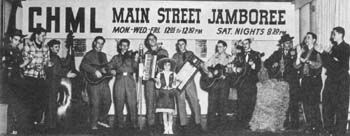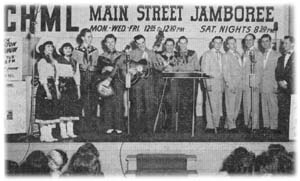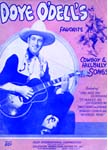CHML Main Street Jamboree
Back in the 1950s, hillbilly music's capital north of
the border in Canada might have been in Hamilton, Ontario.
It was on CHML, 900 on the AM dial, every Saturday night at 8:30pm, the
"Main Street Jamboree" turned into Canada's largest
hillbilly and western music show of its kind. The show originated
from the CHML Auditorium.
We recently had the pleasure of hearing from one of the folks who was
a member of the "Mainstreeters", Roly D'Eon who was kind enough to pass along
some memories of the show.
According to Roly D'Eon, there were three or four country music bands playing
around the Hamilton, Ontario area around 1949. Roly was playing
with Slim Gordon at the time and they heard that CHML was looking for talent
for a new country show they wanted to put on the air.
The group went to audition for the show. Their group wasn't the only one. Another
fellow trying to make his way in the entertainment area was also there to audition,
Gordie Tapp, who came over from Niagara Falls, where he was working on a small
1000 watt radio station. Gordie was trying out for the emcee role. Roly tells
they auditioned, but didn't make the cut at the time.
A bit of time went by and Roly got a call to play bass for a group led by Mike
Patoma. They were going to audition for CHML. Roly went along again, but again,
they didn't get the nod to join CHML.
The pages of time turned again and Dave Folkes and his group of musicians
were going to audition for CHML. Dave needed a bass player as well and Roly was
a known commodity and was asked to help out again. Roly thinks there was a shortage
of bass players in town at the time. He remembers that the technician remarked to him,
"What, you again?". But again, the group didn't win acceptance.
The years start to go by the wayside, and by 1952, CHML still didn't have the show
going. Gordie Tapp made it down for every one of those auditions as well.

When "rustic entertainment" (CHML's term in their publication)
was popular in the early 1950s, they didn't think it was
surprising that CHML would decide to take on the ambitious
project for this type of show in Canada. The programs they
had on the air back then and their listener requests told
their instincts that this was something they needed to do.
Ken Soble and CHML's Manager, Tommy Darling, decided to put
on a two hour program which would be heard every Saturday
night that would be a show-case for the finest folk and
country talent in the business. CHML's Program Director,
Russ Eastcott , was appointed producer , and
so "Main Street Jamboree" was born.
The three gentlemen had some stated goals
in mind when they started the show. They wanted the entertainment
to be appealing to the whole family. They also believed
that programs of this type were as entertaining to see
in person as they were to hear on the air. Its music
would be called "folk music" because "folks" love it.
They also felt that all performers put on a better
show when they have a live audience before them.

As we'll see, the "Hillbilly Jewels" seemed to be the catalyst for the
show getting off the ground and on the air. Roly recalls the group came
down from Owen Sound where they were stationed. It was about fall of 1952.
They auditioned and won the station management over. The show finally
started in November of 1952. The show aired from the basement of the station.
The big stars of the "Main Street Jamboree" was
group called the "Hillbilly Jewels." Each member
of the group was a star in their own right. Mengie
Shulman of Radio Station VOCM, out of Saint John's,
Newfoundland, brought the "Hillbilly Jewels" brought
to CHML's attention when a talent search was being
conducted to start the show.

The Hillbilly Jewels included, Vivian Brown, who was
known as "Brownie, Beautiful Belle of the Ballads."
She sang vocals, played the guitar, fiddle and bass.
She was a songwriter and was said to have several hits
to her credit. Then there was Joe Brown, "Brownie's"
brother, who played the role of emcee for their show,
and doubled as "Little Joe" and "Tiny The Comedian."
He sang vocals, played the guitar and bass Randy Stewart
was tagged "The Louisiana Hillbilly." He was a singing
accordionist and an outstanding showman. He was known
for his sound effects and mimicry. Sam "Speedy" Learning
was an outstanding fiddle player and doubled up by
playing the mandolin, guitar and bass. "Speedy" also
wrote a great number of songs Finally there was Bob
"Windy" Wingrove, acclaimed as the "Star of the Silver
Steel" who played steel guitar for the Hillbilly Jewels.
Roly goes on to note that the station wanted another gorup for the show.
Jack Kingston came down from the CKNX Barn Dance show that was
held in Wingham, Ontario. He brought along Lloyd Bank and Wally Traugott
and became part of the show. But they needed a bass player. Guess who
got the call? Slim Gordon gave them the phone number of Roly and he became
part of the group.
Roly remembers that audition fondly. When he got to the station, thinking
it was another audition, he found many of the folks already there, waiting
for him. Gordie Tapp was there. Maurice Bolyer, Russ Eascott and of course,
Jack Kingston and the band. Roly thought it was an audition, but he tells us,
it was really he who was 'on trial'. After the last note was played and the
dust settled so to speak, Roly was accepted and the band was given the name
the "Mainstreeters" by Russ Eascott.
By early 1953, the show was gaining fans and momentum. Another band joined
the show - the Lincoln County Peach Pickers.
The show of course had its share of guests. Roly recalls that folks such
as Peggie Jo Stewart from Buffalo, the Young Twins (Jean and Joan) from the Welland area, Slim
Gordon, Herb Lewis, Tommy Hunger, Lucille Starr, Myrna Lorrie, Jean Shepard,
Faron Young, Hank Locklin, Ferlin Husky, Hank Thompson, Lefty Frizzell, Wilma
Lee and Stoney Cooper and Dusty Owens among others.
According to Mr. D'Eon, other folks who became regulars on the show were
Glenn Mitchell and Sonny James.
Others who were a part of the CHML Mainstreet Jamboree family included
a little nine-year old singer by the name of Brenda Lee. The Bluegrass King,
Jimmy Martin was there, too.
The show began as a half-hour program on the local station. It later grew
to an hour-long program, of which a half-hour was broadcast over the Canadian
network, coast to coast.
In 1954, television was starting to make its way into the scene. The show's sponsors
wanted to see the show on television, so Ken Soble was given the task to make
it happen. Eventually it did and the show was seen on television, perhaps in
the late summer of 1954.
The show had a square dance group. Mr. D'Eon notes that the group was John Davidson
and "The Canadian Hoedowners". He says they were "...the best dance group I have ever seen."
But they didn't stay with the show - they went to the "Country Hoedown" show. CBC
replaced the group with something "more sophisticated" like the Singing Swinging Eight
group which at the time included a fellow by the name of Gordon Lightfoot.
But as the show's popularity grew, station management at CHCH thought they could
demand more compensation from the show's sponsors. They essentially told the sponors
to either pay a higher sponsorship fee or the show would have be moved from the
prime time Saturday night slot at 7:00pm to Wednesday at 9:00pm. Management claimed
they had another sponsor willing to pay more.
But the sponsors were of the mindset that they were already paying top dollar and
were not willing to pay more. The four sponsors were paying about $1,000 at the time.
The show was moved to Wednesday at 9:00pm as station management threatened. And evidently
did not promote the new timeslot to the listening audience. As one might expect, the ratings
went down.
That seemed to change the atmosphere for the artists with the show. Jack Kingston
decided it was time to move on to Nashville. He wanted the group to go with him,
but no one else did. The Mainstreeters broke up when Jack left. They played around
the Hamilton area for a few more years, but could not use the name as Jack had
bought the rights to the group name.
Eddy Preston became their drummer in 1954 and is still around, in the Oakville area.
Lloyd Bank is in Kitchener, Ontario. Wally Traugott lives in California.
Glenn Mitchell resides in Ancaster. Gordie Tapp is also in the Hamilton area after
enjoying many years on Hee! Haw!. Roly lives between Kingston and Smith Falls, Ontario.
Maurice Bolyer and Jack Kingston have passed away.
The outstanding line-up of outstanding artists that
were a part of CHML's Main Street Jamboree included
folks such as:
- Jack Kingston, Capitol and Arrow recording artist;
- The CHML "Mainstreeters"
- Lloyd Banks
- Wally Traugott
- Jimmy Johnson
- Rolly Dion
- Comedy star Cousin Clem (Gordie Tapp)
- The funny and fabulous "Hillbilly Jewels"
- Gaylord (aka Gordie Tapp), master of "Jamboree" ceremonies
- Elmer & Jed
- Tommy Hunter
- Mike & Rudy Rivers
- Maurice Bolyer, King of the Banjo
- Danny Webster
- Steve Terlesky
- Lincoln County Peach Pickers, with Eric & Johnny; Bonnie Miller and Herb Lewis
- Slim Gordon and his group
- Bill Long and his group
- Mel Lavigne and the Blue Water Boys
- Eddie Nehler
The Main Street Jamboree also invited guest stars from across Canada
and from the USA to appear on the show. These included such folks as
- Dude Rangers with little Peggy Jo Stewart
- Les & Jean (the "Colorado Kids")
- Clarke Wallace
- Carl Smith
- Audrey Williams
- Ray Price
- Grampa Jones
- Stoney Cooper and Wilma Lee
- Lefty Frizzell

We should mention a bit more about a couple of other stars on the
show and let you explore the list of cast members for more information.
One star of "Main Street Jamboree" and a permanent member
of its cast since the first program, was a young and talented
Jack Kingston. Jack appeared as a featured star on
many radio stations in Canada and the United States.
He also guested on the famed WLS National Barn Dance in Chicago.
For many months, CKNX featured Jack and his yodeling on the CKNX
Barn Dance.
He was known as one of the best yodelers at the time
but in addition to that singing talent, he was also one of the
best square dance callers. And on the Main Street Jamboree, it was his
calls that accompanied the music of the Main Streeters or the Hillbilly Jewels.
Another star on the show was a fellow they called Gaylord who was the
"effervescent" emcee, whose "...verve and good humor spark
every program." When he wasn't doing the emcee chores for the Main
Street Jamboree, he played the part of entertainer and
radio personality, Gordie Tapp, who as we know went on to some fame later
in his career as part of the long running legendary cast of Hee! Haw!.
He had a show back then called "What's On Tapp" that he originated
in 1946 on a radio station in Niagara Falls, then moved to Guelph,
on radio station CJOY. From 1949 onwards to 1952 when we read about this,
he was heard six nights a week, from 10:30pm to midnight on CHML.
Credits & Sources
- Hillbilly-Music.com wishes to express its appreciation
to Roly D'Eon, former member of the Mainstreeters for contacting us and providing
us with his recollections of the show's history.
- CHML Main Street Jamboree Book No. 1, 1953, BMI Canada Limited, 229 Yonge Street, Toronto, Ontario, Canada
- Country Song Roundup No. 31 (May 1954), American Folk Publications, Inc., Derby, CT




